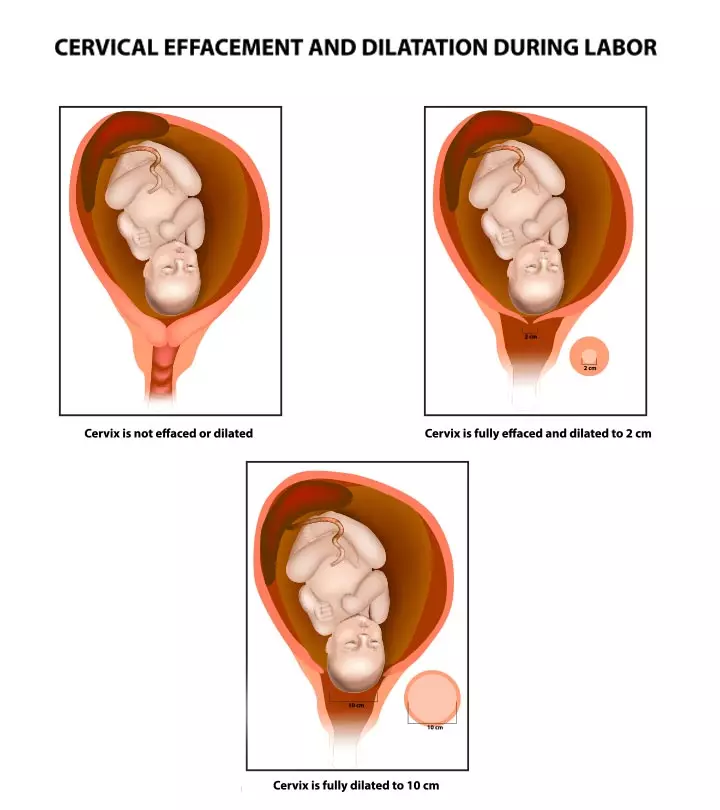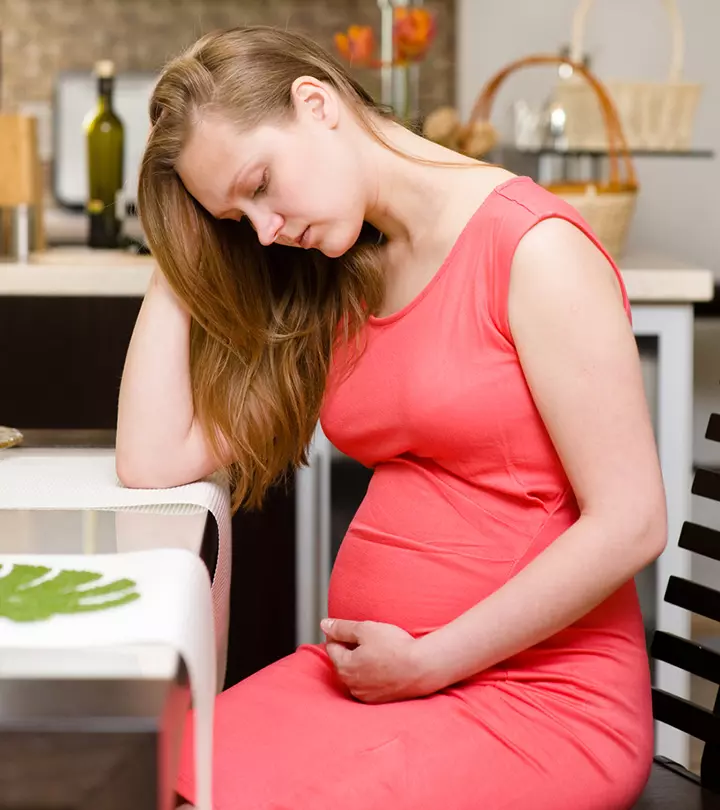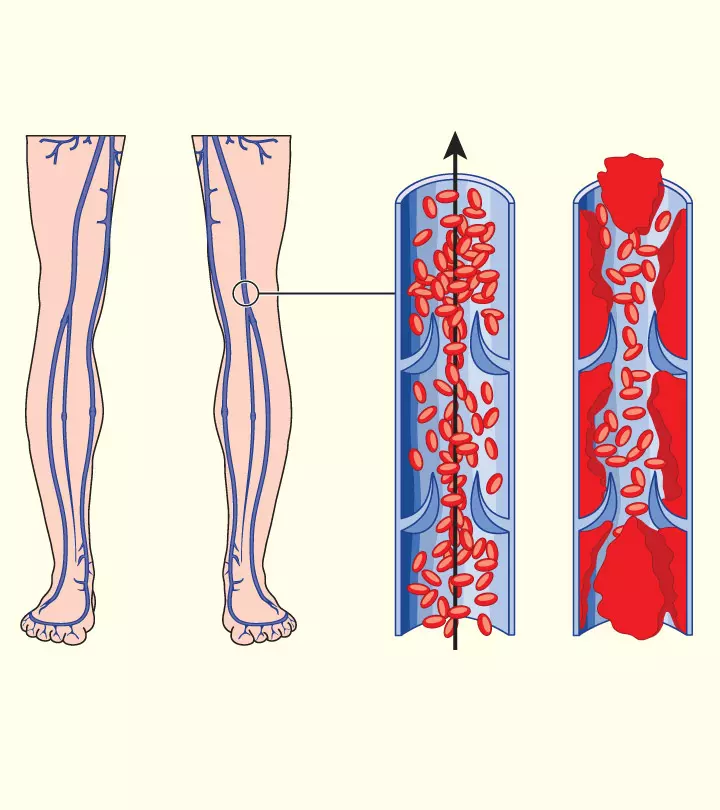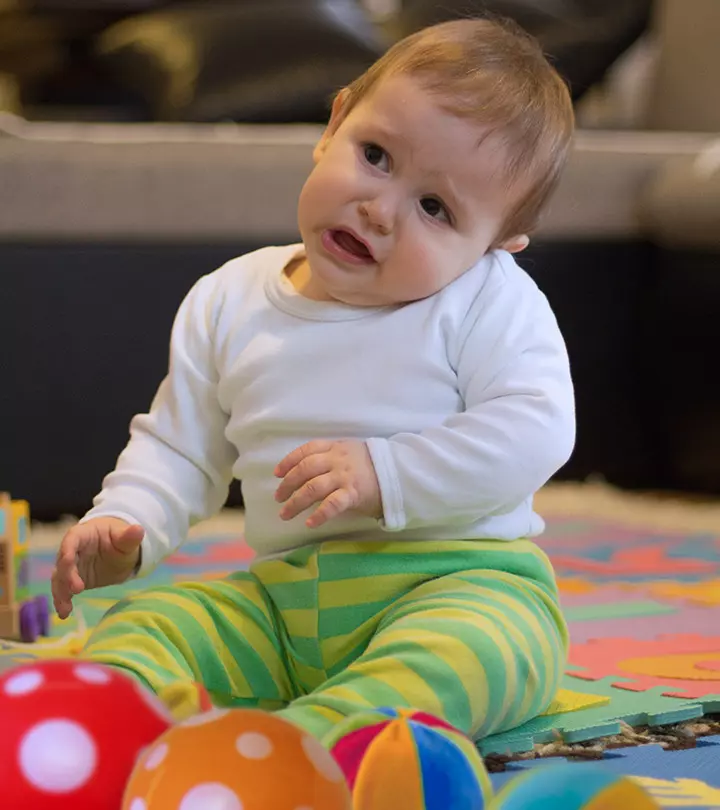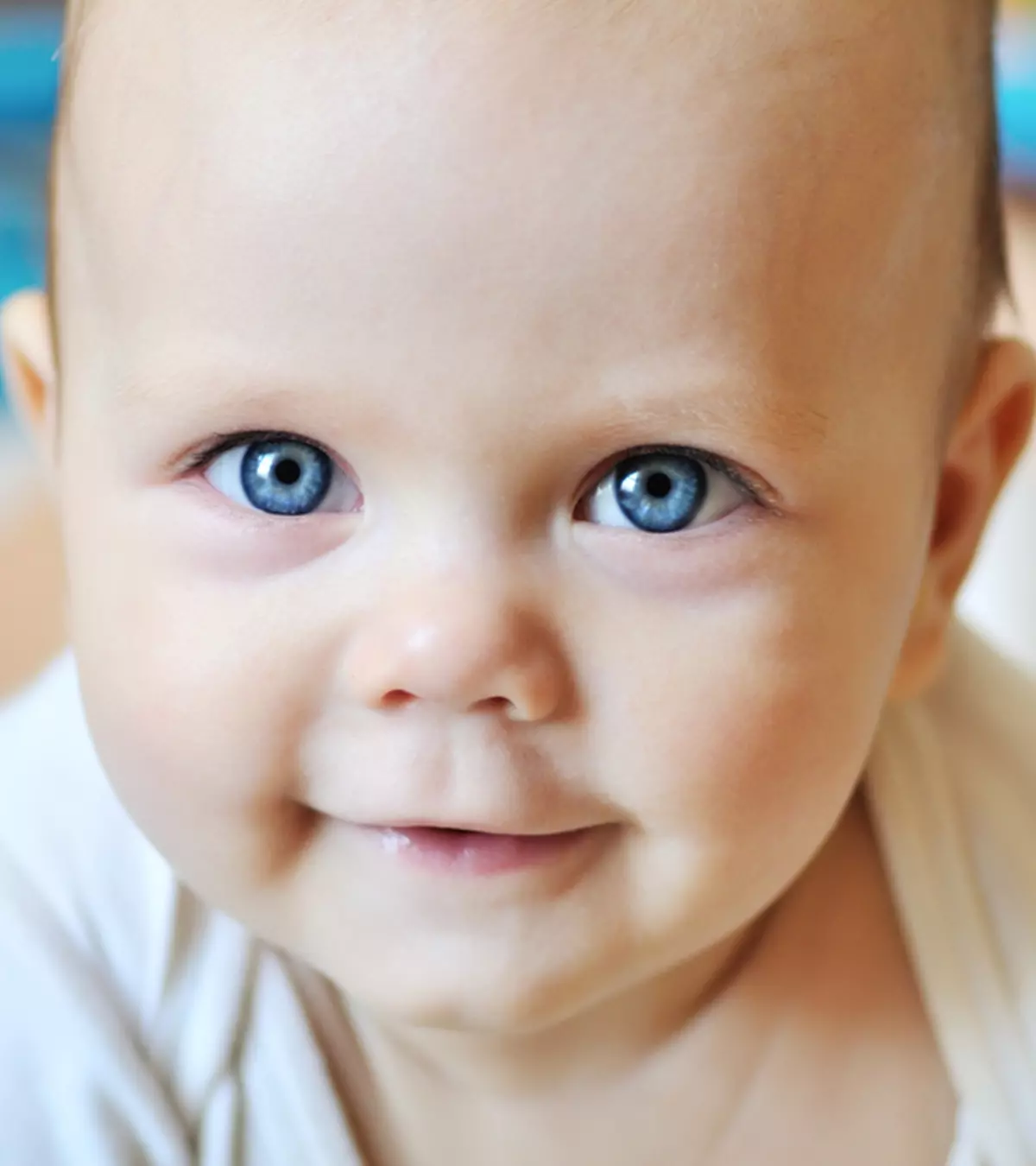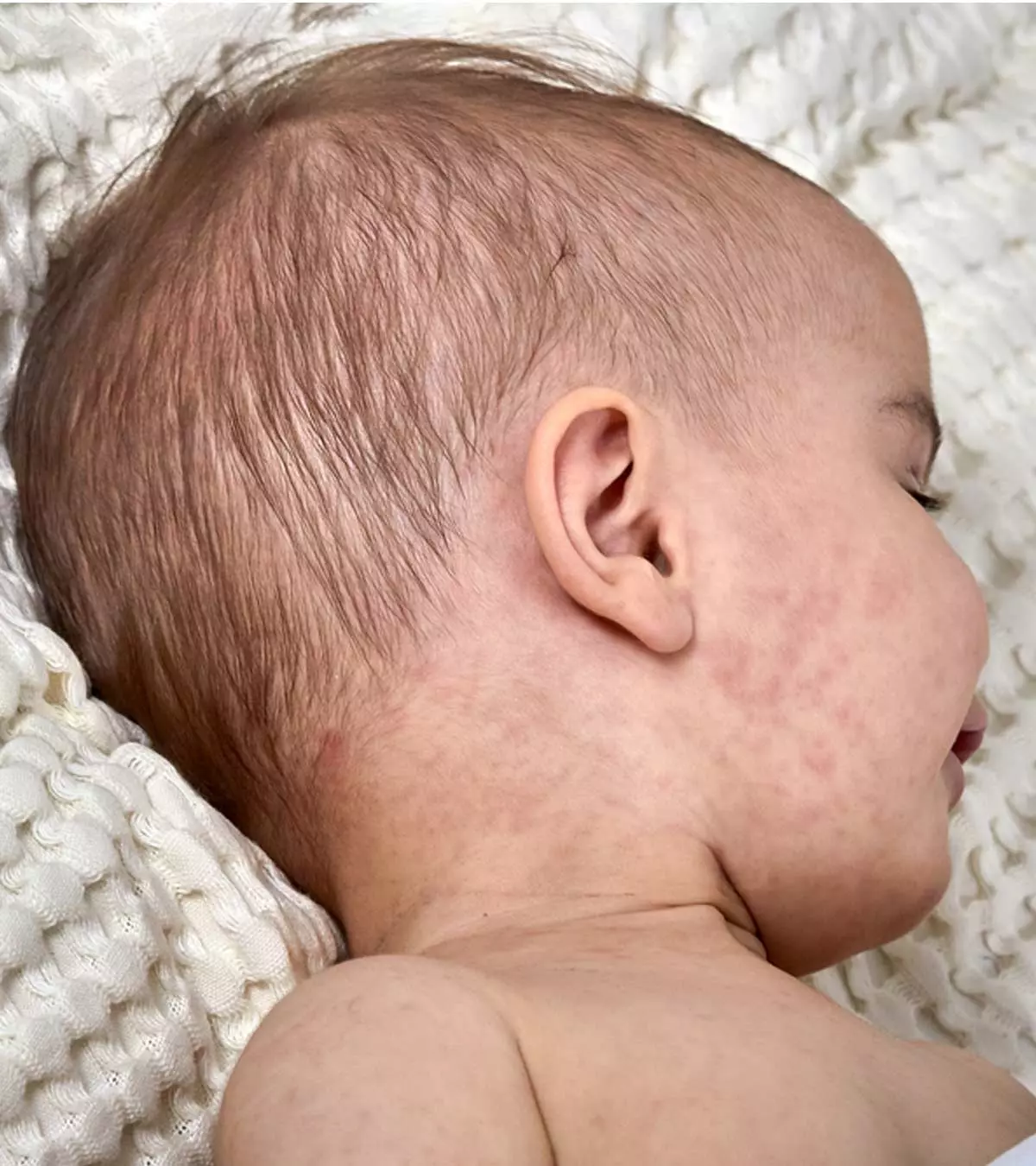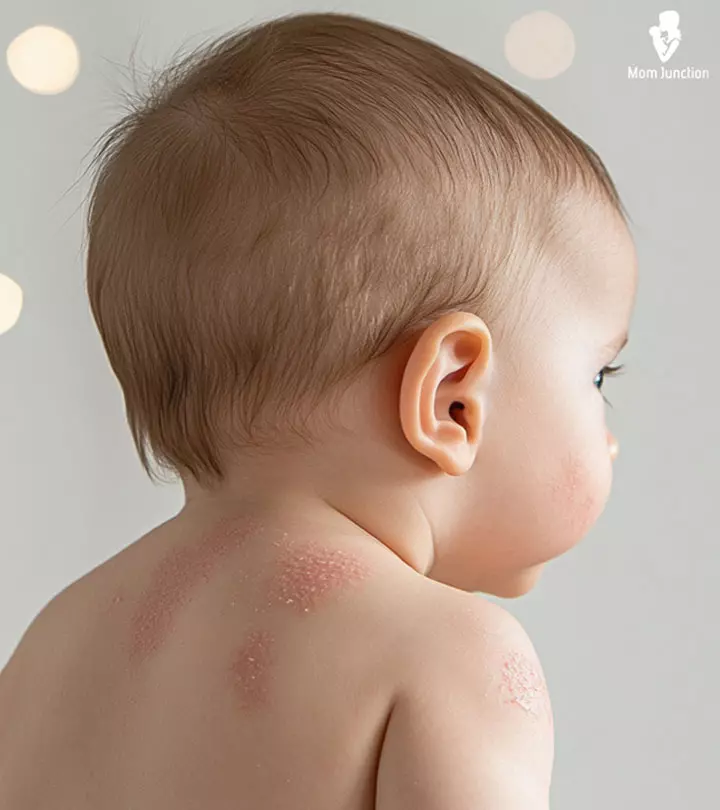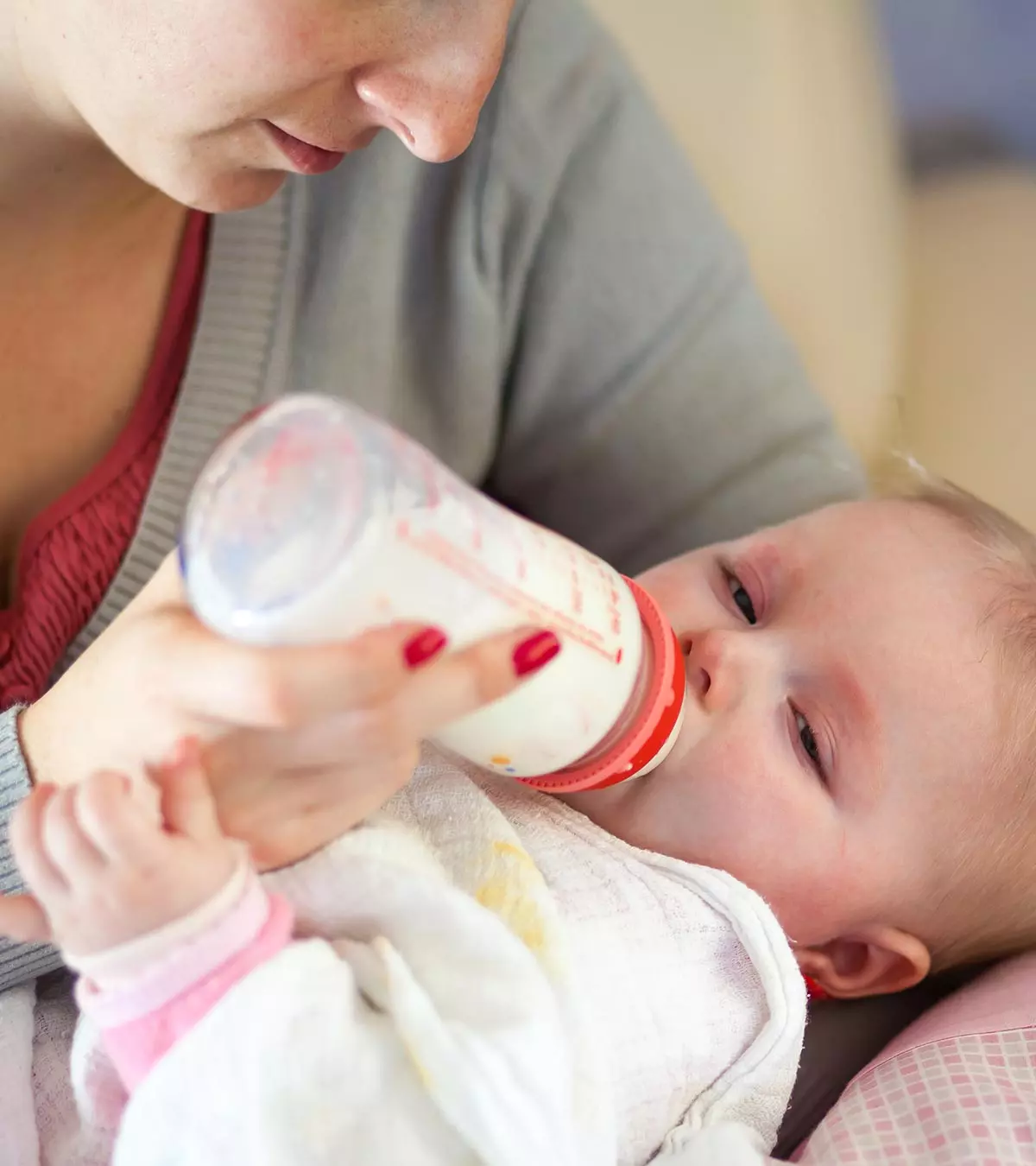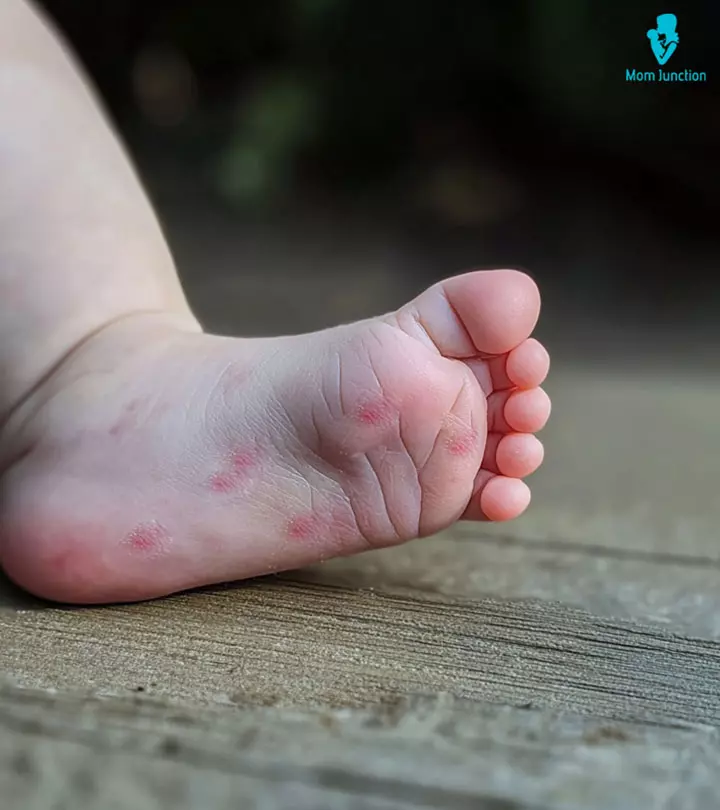
Image: Midjourney/ MomJunction Design Team
You notice blistersiA painful swelling on the skin, filled with a clear, watery liquid in your baby’s mouth, and eventually, rashes on the palms and soles of the feet. These could be signs of hand, foot, and mouth disease in babies. Though mostly mild, it is a common infection that causes inflammation and characteristic rashes on the skin around the lips, palm, foot soles, and inside the mouth. The condition may also cause a lot of discomfort and loss of appetite in babies. Keep reading to understand the possible causes, signs, treatment, and management of babies’ hand, foot, and mouth disease.
Key Pointers
- HFMD is a common infection that causes fever, sores in the mouth, rashes on the skin, pain while swallowing, loss of appetite, fussiness, and lethargy.
- HFMD can be contracted by your baby through an infected person, inhaling saliva or mucus during sneezing, not washing after touching fecal matter, or sharing utensils.
- The disease is treated with pain and fever medication, and oral anesthetic solutions.
- To help your baby at home, offer plenty of fluids, switch to a liquid diet, feed smaller portions, and allow for plenty of rest.
- HFMD can cause complications such as dehydration, temporary loss of fingernails and toenails, infections, meningitis, and, rarely, encephalitis.
What Is Hand, Foot, And Mouth Disease?
The disease, as the name suggests, is an infection that affects the skin of the hand, feet, and around the mouth. LesionsiAn injury or an abnormal change in an organ due to trauma or a chronic illness might also be visible in the inner mucous membranesiInner lining that covers the surface of internal organs, including the nose, eye, lungs, and stomach of the mouth such as behind the lips, back of the cheeks, and the back of the throat too. In some cases, the condition may also affect the buttocks and genital area (1).
What Causes HFMD In Infants?
Any of the viruses from the enterovirusiA group of viruses causing mild illnesses like the common cold genus or group can cause HFMD. The most common enteroviruses to cause this infection are the coxsackievirusiA common type of virus affecting the hand, foot, and mouth and has symptoms like fever, sore throat, and runny nose A16 and enterovirus 71. The coxsackievirus A16 is usually the cause of HFMD in North America while enterovirus 71 is responsible for it in East and Southeast Asia (2).
 Quick fact
Quick factHow Does A Baby Catch The HFMD Virus?
HFMD is extremely contagious. The virus first multiplies in the cells of the digestive tract before spreading to different parts of the body, such as the mouth, throat, skin, brain, spinal cord, and heart. People with the infection are most contagious during the first week of illness (4). A baby or a toddler can quickly catch the virus through (2):
- Skin contact with an infected person: Babies can contract the virus if they come in contact with an infected person through handshakes and hugs. Kissing the child on the cheek can also spread the virus through the blisters around the mouth.
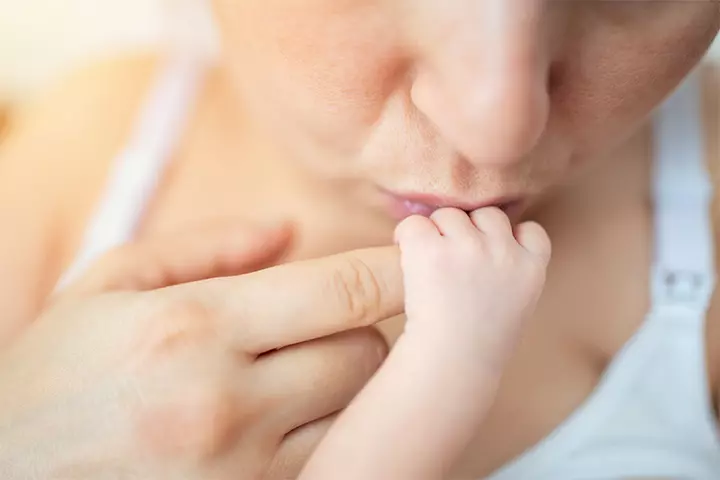
- Inhaling the saliva or mucus expelled during sneezing: Inhalation of the expelled mucus and saliva droplets while sneezing or coughing by an infected person, spreads the virus.
- Not washing hands after touching fecal matter: HFMD viruses also transmit through the fecal-oral route. Maintaining and following proper hygiene for kids is essential to prevent transmission of viruses. For example, A baby or toddler may catch the virus by playing with soil contaminated with infected feces. A toddler may get the virus from their sibling if they touch the soiled diaper and do not wash hands.
- Contaminated food and water: Food and water contaminated with fecal matter can spread the disease.
- Touching contaminated surfaces: Viruses can survive on inanimate objects too. It means HFMD can spread through objects, such as clothes, doorknobs, and toys, used by the infected person.
- Sharing utensils: A baby can get the virus if they share utensils like sippy cups with an infected person like a sibling or a parent.
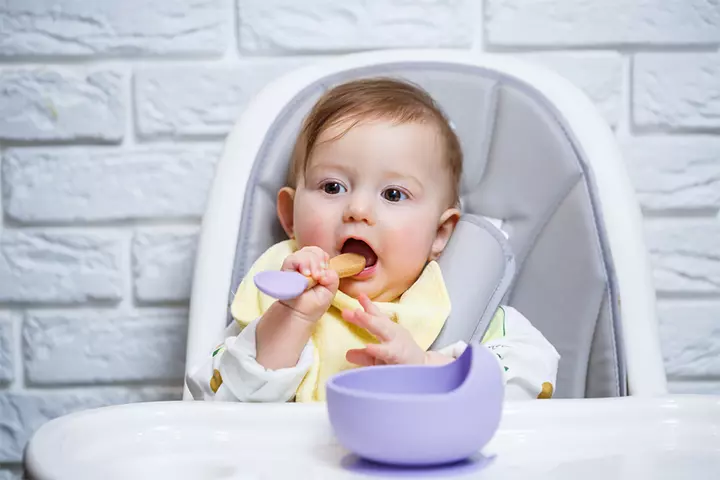
How Common Is HFMD In Babies?
HFMD mostly affects infants and toddlers, rather than older children and teens. The disease is prevalent during the summer and the winter season (5).
What Are The Symptoms Of HFMD In Babies?
The HFMD virus has an incubation periodiThe period between infection caused by some bacteria or viruses and the appearance of its symptoms. of three to six days. It means the baby will display the first symptoms of the disease about three to six days after he/she contracts the virus (6). The following are the symptoms of hand, foot, and mouth disease in babies and toddlers (7)(8)(9):
- Fever: It is usually the first symptom of the disease and appears even before the development of the rash. A fever is defined as a temperature above 100.4°F (38°C) (10). However, the baby is most likely to display a low-grade fever, which is a temperature between 100°F and 100.2°F (37.7°C – 37.8°C) (11).
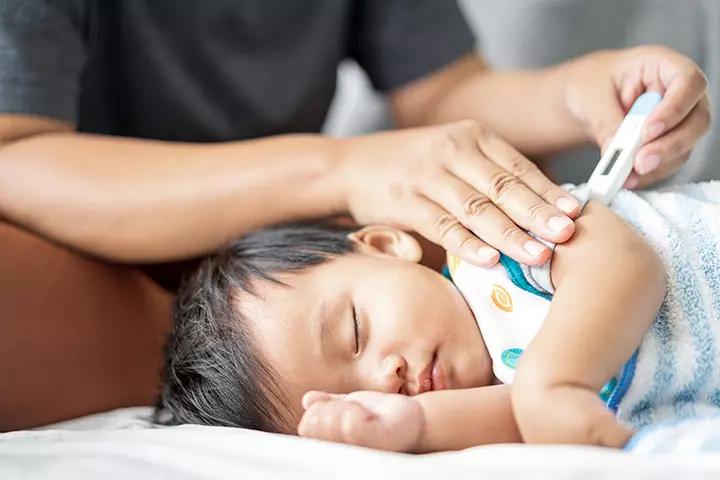
- Sores in the mouth: About a day or two after the onset of fever, you notice the eruption of sores all around the mouth. Clear-to-cloudy, tiny, liquid-filled blisters appear inside the mouth and cheeks, gums, tongue, the upper palate of the mouth, and even the back of the mouth, near the tonsils. Sometimes, the blisters may appear yellow, indicating pus formation.
- Rashes on the hands and sole of the feet: The rashes on the hands and feet gradually sprout over two to three days. They could appear anywhere on the hand or feet but are mostly concentrated on the palms and soles. The tiny blisters are red to pink in color, irregularly-shaped, and scattered all around without any pattern. Sometimes, you may notice rashes even on the knees, elbows, buttocks, and the groin/diaper area.
- Pain in swallowing: The baby will find swallowing painful and would pause during feeds. Older toddlers may point towards the neck while eating and drinking to tell they have pain.
- Loss of appetite: Since swallowing anything becomes painful, you may notice loss of appetite in toddlers and babies. Your child may refuse to eat or drink anything.

- Fussiness and lethargy: The baby will feel fussy, and also very lethargic. Toddlers may show no interest in playing with toys or with their friends and siblings.
Holly, a mother of three, recounts the symptoms she noticed when her son contracted hand, foot, and mouth disease, “When Itty Bitty (the son) came down with a low-grade fever, I assumed teething. A few days later, I noticed some redness and bumps around his mouth. I thought it was a rash from drooling. Then he started getting bumps elsewhere. Eventually, those bumps grew in volume and congregated around his hands, feet, mouth, and diaper area. By the end of the week, I was pretty positive it was hand, foot, and mouth (i).”
Several symptoms of HFMD resemble those of other diseases such as chickenpox, herpesiA group of viruses that causes painful blisters around the mouth or genitals , and even strep throatiA bacterial infection that causes a sore and scratchy throat . It means you are quite likely to get confused about what is happening with the baby. Since many different viruses can cause HFMD, the presentation is not always the same (2). There are varieties where the child will only get skin signs or mouth lesions. For these reasons, it is best to take the baby to the doctor for an accurate diagnosis of the condition.
Seek immediate medical attention if your child experiences severe and persistent symptoms for several days, such as a high fever, difficulty swallowing, or signs of dehydration. Early treatment can help prevent complications and ensure your child receives the proper care.
How Is HFMD In Babies Diagnosed?
The following steps help a healthcare provider to diagnose the disease (12)(13):
- Visual inspection: The doctor looks for the tell-tale signs of the disease, which is the presence of blisters mostly on the mouth, palms, and soles of the feet.
- Mouth and throat swab: A swabiA small piece of soft material or cotton for cleaning wounds or taking a sample sample from the throat and mouth is sent for laboratory analysis to determine the presence of the virus.
- Stool test: Since the HFMD virus is excreted in stool, the doctor will send a stool sample to check for the presence of the virus.
- Biopsies: To distinguish HFMD from other viral infections like chickenpox (varicella-zoster) or herpes, doctors may examine samples from skin blisters under a microscope.
- Blood test (not often done): A blood test will help confirm the diagnosis by assessing the presence of the virus and its related antibodies in the blood.
If the diagnosis is definite, the doctor will begin the treatment.
How Is HFMD In Babies Treated?
There is no treatment for hand, foot, and mouth disease (14). Antibiotics do not work against the illness since it is caused by a virus and not a bacteria. Just like with any other viral infection, one needs to wait for the immune system to subdue the virus on its own. The baby’s doctor can suggest some medicines to ease the intensity of the symptoms (13):
- Pain and fever medication: The doctor can prescribe acetaminophen (paracetamol) or ibuprofen to bring down the fever and ease the pain caused by the blisters. Although these medicines are available over-the-counter, it is best to consult a doctor for the dosage based on your baby’s age and intensity of symptoms.
- Oral anesthetic solutions: You can use oral anesthetic solutions to numb the pain in the baby’s mouth. However, do so as per the doctor’s recommendation and avoid using any over-the-counter numbing gels, mouthwashes, and sprays.
- If some of the lesions are open and appear to be infected, your healthcare provider might apply some antibacterial ointment.
A study assessed the effectiveness and immune response of the Sinovac Enterovirus 71 (EV71) vaccine over a two-year period. The report states, “The EV71 vaccine showed an efficacy of 95.1% (95% CI 63.6, 99.3) against EV71-associated HFMD during the extended follow-up and an overall efficacy of 94.7% (95% CI 87.8, 97.6) for two years (15).” However, studies evaluating its effectiveness specifically in children remain limited.
Home management is the best way to help the baby feel better and increase the speed of recovery.
How To Help A Baby With HFMD Feel Better At Home?
Here are a few home remedies to help the baby feel better (16) (17):
- Offer plenty of fluids: The soreness of the blisters, along with fever and the inability to feed correctly can increase the risk of dehydration. Therefore, offer plenty of fluids such as milk and water. You can give them cold beverages that help soothe the irritation inside the mouth. Do not provide juices since they have excess sugars and are not recommended by pediatricians (18).
- Switch to a liquid diet: Puree everything that you would otherwise feed as solid to the baby. You can feed a wide variety of fruit, vegetable, and meat purees. You can also give vegetable or meat broth to the baby. Continue breastfeeding the usual way.
- Feed smaller portions: Give smaller portions of liquids that are easier to gulp than large quantities in one go.
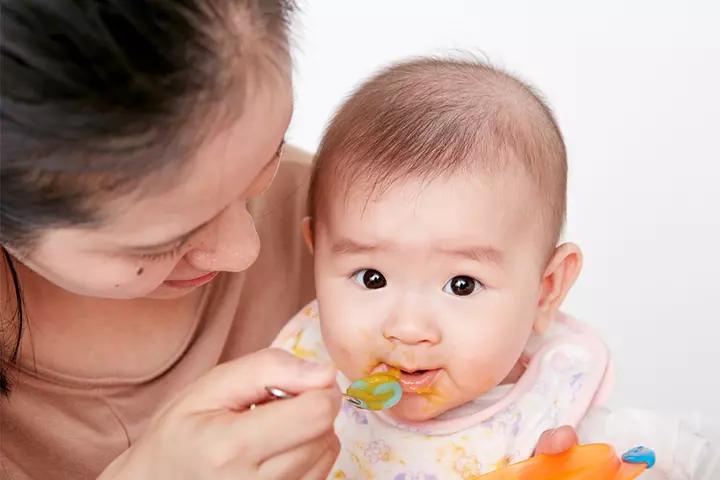
- Try feeding about 20-30 minutes after the anti-pyrexial and pain medications were given.
- Rest is essential: Adequate rest allows the body’s immune system to work better and recover from the illness faster. Cut down on play time and focus more on rest.
Babies with hand, foot, and mouth disease should be kept home from childcare until they are no longer contagious. The illness usually goes away in seven to ten days (19).
Pediatrician Dr. Bidisha Sarkar says, “Parents can also contract hand, foot, and mouth disease, but it is not very common. Nevertheless, it is important to be careful when taking care of the baby—washing hands frequently can help to some extent.”
The baby should start recovering within a week. Blisters on the hand and feet become dry and fall away while the sores in the mouth gradually disappear. In very rare instances, the disease may extend beyond two weeks, but it is usually with immunocompromised babies and infants with other health problems. These babies are also at a higher risk of developing complications of HFMD.
What Are The Complications Of HFMD?
Sometimes the HFMD virus may lead to a few complications, including (13) (20):
- Dehydration: It is by far the most common complication of HFMD. Dehydration in toddlers and babies is a tangential result of sores in the mouth, which makes it difficult for the baby to drink and swallow. If the baby is urinating less frequently, with fewer than six wet diapers used a day, it is an indication of dehydration among infants. In toddlers, not urinating for more than six hours could indicate dehydration (21) (22).
- Temporary loss of fingernail or toenail: If a blister erupts beneath the fingernail or toenail, then the baby risks the loss of that nail. However, the loss is temporary, and the nail will regrow from the nailbed.
- Opportunistic infections: Since the immune system is busy fighting the virus, it could make the body prone to other opportunistic pathogens. Studies have found that HFMD may increase the risk of other bacterial and viral infections caused by the Streptococcus bacteriaiA spherical bacteria which causes minor to serious conditions, including pneumonia, skin infections, and sore throat and dengue virus among others (23).
- Viral meningitis: It is a rare complication where the virus finds its way into the brain, infecting the meninges, which is the outer layer of tissue covering the brain. The infection leads to viral meningitis.
- Encephalitis: It is the rarest of all the complications. In this case, the virus infects the brain and causes severe inflammation of the brain tissue, a condition called encephalitis.
 Quick fact
Quick fact In most cases, the baby recovers well with no complications. However, an infected person can transmit the virus for a week or two even after the disease is cured. Prevention is thus vital.
How To Prevent HFMD In Babies?
Dr. Sarkar says, “The best way to stop hand foot and mouth from spreading is by practicing good hygiene. Make sure that everyone in your household washes their hands with soap and water frequently, especially after coming into contact with the infected area. It is also important to keep surfaces and objects clean and disinfected. Avoid sharing cups, utensils, towels, or any other items that can come into contact with saliva or fluid from blisters.”
The following steps can help prevent HFMD in babies (25)(26)(27):
- Wash the baby’s hands periodically. Always wash the baby’s hands with warm and soapy water after a trip to the park or play time outdoors. Wash your hands when you come back home from outside.
- Cover nose and mouth when sneezing or coughing. Cover your nose and mouth when you sneeze or cough, whether or not you are infected. Sometimes adults may have the virus but may display mild symptoms or no symptoms at all. But the baby can still get the infection and exhibit severe symptoms.
- Wash hands before touching the baby. Clean and dry your hands before holding the baby or the items. It mitigates accidental exposure to the dormant virus.
- Disinfect the baby’s personal items and household objects. Wipe the baby’s toys with a cloth dipped in diluted, baby-safe antiseptic liquid. If the toys are washable, then wash them with soapy water. Clean household objects that the baby is bound to touch like doorknobs with a cloth dipped in a disinfectant liquid.
- Do not share utensils with the baby: Use a separate set of utensils for the baby and do not let anyone else use them. If your child is enrolled in a daycare, it is recommended to have a conversation with the provider regarding their strategies and protocols in preventing any potential outbreak or spread of illnesses.
Ashley, a mother and blogger, shares how she successfully prevented the spread of HFMD from her son to the rest of her family. She explains, “My youngest kid had HFMD, and I took some extra steps to ensure it didn’t spread to my daughter, husband, or me. These measures might have even helped my son recover faster—who knows? I washed all the clothes and blankets that came into contact with my son during his illness on the hottest cycle—I made sure to keep his skin from staying moist. Offering plenty of ice and cold drinks helped soothe his mouth and fever, while soft and gushy foods made eating easier for him—Alternating Motrin and Tylenol helped manage his fever, and once the bumps dried out, we applied Sudocrem (similar to calamine lotion) to aid in healing (ii).”
 Did you know?
Did you know?Hand, foot, and mouth disease in babies is common but can cause extreme irritation and thus interfere with the baby’s daily routine. It is easy to identify this disease due to its characteristic viral rashes in babies and accompanying symptoms, and hence you can seek timely treatment. It is not an alarming condition, so do not worry and take the necessary steps to keep your baby hydrated and ensure they get the rest they need for a speedy recovery. In addition, since hand, foot, and mouth disease is contagious, following the preventive measures will help avoid contracting the infection.
Frequently Asked Questions
1. What is the long-term outlook for babies with hand, foot and mouth disease?
The clinical outcome for most individuals with hand, foot, and mouth disease is positive. The recovery process typically occurs spontaneously over a few weeks without residual long-term effects (13). The acute phase of illness can persist for approximately 10 to 14 days, but a relapse of the infection or a prolonged disease state is rare (29).
2. What is the mortality rate for babies’ hand, foot and mouth disease?
Although the hospitalization rate for HFMD is only 6%, 18.7% of these cases are expected to develop complications, and a staggering 5% are fatal. These numbers reveal that the overall case-fatality ratio for HFMD is 52.3 per 100,000 symptomatic infections (30).
3. What is the difference between hand foot and mouth disease and chickenpox in babies?
Hand, foot, and mouth disease generally causes spots on the hands, feet, and face, while the rash from chickenpox often spreads throughout the body. The period of contagion lasts until all the spots have scabbed over (31).
4. Is a bath good for hand, foot and mouth disease?
Dr. Sarkar opines, “In most cases taking a warm bath can help soothe the discomfort to some extent. Make sure to use mild soap and keep the water temperature lukewarm (not too hot). After the bath, pat your child’s skin dry with a soft towel—do not rub as this could also cause irritation and pain.”
Infographic: Conditions That Produce Symptoms Similar To HFMD
Other health conditions that cause rashes in babies may be mistaken for HFMD. So it is essential to get the condition diagnosed by a registered physician. The infographic below provides a list of conditions whose symptoms may resemble HFMD. Illustration: Momjunction Design Team
Illustration: Symptoms And Causes Of Hand Foot And Mouth Disease In Babies

Image: Dall·E/MomJunction Design Team
Learn about the importance of hydration to combat Hand, Foot, and Mouth Disease, ensuring your body remains hydrated while fighting off the virus in this video.
Personal Experience: Source
MomJunction articles include first-hand experiences to provide you with better insights through real-life narratives. Here are the sources of personal accounts referenced in this article.
i. Surviving hand, foot, and mouth disease.https://www.simplyhollyjo.com/surviving-hand-foot-and-mouth-disease/
ii. A Mama’s Guide To Hand, Foot, And Mouth Disease.
https://thedailymamadotblog.wordpress.com/2021/09/13/a-mamas-guide-to-hand-foot-and-mouth-disease/
References
- Hand, Foot, and Mouth Disease.
https://www.ncbi.nlm.nih.gov/books/NBK431082/ - HFMD: Causes and How It Spreads.
https://www.cdc.gov/hand-foot-mouth/causes/?CDC_AAref_Val=https://www.cdc.gov/hand-foot-mouth/about/transmission.html - Hand, Foot and Mouth Disease (Coxsackie viral infection).
https://www.health.ny.gov/diseases/communicable/hand_foot_mouth/fact_sheet.htm - HAND, FOOT, AND MOUTH DISEASE.
https://healthservices.appstate.edu/files/filecabinet/folder19/Traveler_Information___Hand__Foot__and_Mouth_Disease.pdf - Hand-Foot-and-Mouth Disease.
https://www.chop.edu/conditions-diseases/hand-foot-and-mouth-disease - Nathan Y Hoy et.al; (2012); New Concepts in Median Nail Dystrophy Onychomycosis and Hand Foot and Mouth Disease Nail Pathology.
https://www.ncbi.nlm.nih.gov/pmc/articles/PMC3302018/ - Hand-Foot-and-Mouth Disease in Children.
https://www.urmc.rochester.edu/encyclopedia/content.aspx?contenttypeid=90&contentid=P01857 - Hand, Foot and Mouth Disease.
https://www.moh.gov.sg/seeking-healthcare/overview-of-diseases/communicable-diseases/hand-foot-and-mouth-disease - Hand, foot, and mouth disease (HFMD).
https://familydoctor.org/condition/hand-foot-and-mouth-disease/ - Signs and Symptoms of Fever.
https://www.healthychildren.org/English/health-issues/conditions/fever/Pages/Signs-and-Symptoms-of-Fever.aspx - When to Worry About Your Child’s Fever and When to Stay Calm.
https://healthcare.utah.edu/the-scope/kids-zone/all/2024/12/when-worry-about-your-childs-fever-and-when-stay-calm - Hand, Foot and Mouth Disease.
https://my.clevelandclinic.org/health/diseases/11129-hand-foot-and-mouth-disease - Hand Foot And Mouth Disease
https://www.ncbi.nlm.nih.gov/books/NBK431082/ - HFMD Symptoms and Complications.
https://www.cdc.gov/hand-foot-mouth/signs-symptoms/?CDC_AAref_Val=https://www.cdc.gov/hand-foot-mouth/about/signs-symptoms.html - Jing-Xin Li et.al; (2016); Two-year efficacy and immunogenicity of Sinovac Enterovirus 71 vaccine against hand, foot and mouth disease in children.
https://pubmed.ncbi.nlm.nih.gov/26460695/ - How To Prevent And Treat Hand, Foot, And Mouth Disease.
https://choc.org/news/how-to-prevent-and-treat-hand-foot-and-mouth-disease/ - What to Do if Your Child Has Hand, Foot and Mouth Disease.
https://www.chop.edu/news/health-tip/hand-foot-and-mouth-disease-what-you-need-know#:~:text=How%20to%20treat%20hand%2C%20foot,needed%20to%20maintain%20blood%20pressure. - AAP Recommends No Fruit Juice for Children Under 1 Year.
https://www.healthychildren.org/English/news/Pages/AAP-Recommends-No-Fruit-Juice-for-Children-Under-1-Year.aspx - About Hand, Foot, and Mouth Disease.
https://www.cdc.gov/hand-foot-mouth/about/index.html#:~:text=HFMD%20is%20usually%20not%20serious,or%20your%20child%20are%20sick. - Hand Foot and Mouth Disease.
https://texashelp.tamu.edu/wp-content/uploads/2016/02/hand-foot-and-mouth-disease.pdf - Vomiting and Diarrhea.
https://familydoctor.org/condition/vomiting-and-diarrhea/ - Gastroenteritis (stomach/intestinal flu) self-care tips.
https://pr.princeton.edu/news/02/q1/0214-caretips.htm - Enterovirus 71 cited in puzzling Cambodian infections.
https://www.cidrap.umn.edu/enterovirus-71-cited-puzzling-cambodian-infections - Hand-foot-mouth disease
https://medlineplus.gov/ency/article/000965.htm - Hand foot and mouth disease.
https://www.nhs.uk/conditions/hand-foot-mouth-disease/#how-to-stop-it-spreading - What Child Care Providers Should Know About Hand-Foot-and-Mouth Disease.
https://cchp.ucsf.edu/resources/illness-sheets/hand-foot-and-mouth-disease-coxsackie-virus-a16 - Understanding Hand, Foot, and Mouth Disease (HFMD).
https://myhealth.ucsd.edu/RelatedItems/3,89371 - Zhixi Liu et.al; (2021); The burden of hand, foot, and mouth disease among children under different vaccination scenarios in China: A dynamic modelling study.
https://www.ncbi.nlm.nih.gov/pmc/articles/PMC8259139/ - Nilendu Sarma; (2013); Relapse of Hand Foot and Mouth Disease: Are We at More Risk?
https://www.ncbi.nlm.nih.gov/pmc/articles/PMC3555383/ - Wee Ming Koh et.al; (2018); Severity and burden of hand, foot and mouth disease in Asia: a modelling study.
https://pmc.ncbi.nlm.nih.gov/articles/PMC5859810/ - What is the difference between hand, foot and mouth disease and chickenpox?
https://patient.info/news-and-features/what-is-the-difference-between-hand-foot-and-mouth-disease-and-chickenpox
Community Experiences
Join the conversation and become a part of our nurturing community! Share your stories, experiences, and insights to connect with fellow parents.
Read full bio of Dr. Wayne Hough
- Dr. Bidisha Sarkar is a pediatrician with nine years of experience. She did her graduation in Medicine from NRS Medical College, Kolkata and holds specialization in Pediatrics. Dr. Sarkar currently practices at KIMS Hospital in Hyderabad, India.
 Dr. Bidisha Sarkar is a pediatrician with nine years of experience. She did her graduation in Medicine from NRS Medical College, Kolkata and holds specialization in Pediatrics. Dr. Sarkar currently practices at KIMS Hospital in Hyderabad, India.
Dr. Bidisha Sarkar is a pediatrician with nine years of experience. She did her graduation in Medicine from NRS Medical College, Kolkata and holds specialization in Pediatrics. Dr. Sarkar currently practices at KIMS Hospital in Hyderabad, India.
Read full bio of Rohit Garoo
Read full bio of Dr. Ritika Shah
Read full bio of Shinta Liz Sunny








